- About us
- Support the Gallery
- Venue hire
- Publications
- Research library
- Organisation chart
- Employment
- Contact us
- Make a booking
- Onsite programs
- Online programs
- School visit information
- Learning resources
- Little Darlings
- Professional learning
Trukanini (c. 1812–1876) is arguably nineteenth century Australia’s most celebrated Indigenous leader. A Nuennone woman and the daughter of Mangana, chief of the Recherche Bay people, Trukanini experienced the loss of her mother, sister and intended husband – all as a result of white violence – at a young age. Believing that she might be able to assist in protecting her people, in 1829 Trukanini joined the group of Palawa leaders associated with George Augustus Robinson, an evangelically-inclined free settler who'd been appointed to effect the removal of Tasmania's Aboriginal people to a mission station, Wybalenna, on Flinders Island in Bass Strait. Trukanini remained one of Robinson's most important companions throughout the course of his so-called 'Friendly Mission', the name given to a series of journeys conducted by Robinson between 1830 and 1835. Trukanini went to Wybalenna in 1835, but held to her traditional ways despite the expectation that the Aboriginal people there would adopt European customs and religion. She travelled with Robinson in 1839 to the Port Phillip district, where she later engaged with four others in raids against white settlers. She returned to Flinders Island in 1842; when Wybalenna closed in 1847, Trukanini was among the remaining residents relocated to Oyster Cove, a former convict depot south of Hobart and close to her traditional country. Trukanini died in Hobart in May 1876. As she had feared, her skeleton was stolen from her grave and later displayed at the Tasmanian Museum. The Tasmanian Aboriginal community eventually won the fight to have her wishes honoured: her bones were cremated on the 30th of April 1976 and the following day her ashes were scattered with due ceremony on the D'Entrecasteaux Channel. Trukanini was erroneously referred to during her lifetime and beyond as the ‘last Tasmanian’ – a false notion attested to by the many descendants of her contemporaries still living in Tasmania today.
Sheffield-born sculptor Benjamin Law (1807–1890) arrived in Hobart as an assisted immigrant in February 1835. He became acquainted with George Augustus Robinson soon afterwards and through him met Wurati, Trukanini's partner. Despite being advised that ‘the Colony [was] too young’ for him to make a living as a sculptor, Law recognised that there was demand for likenesses of Aboriginal people: a demand driven in part by the colonists’ belief that Tasmania’s Aboriginal people were destined to disappear. Law’s bust of Wurati – considered the first portrait sculpture created in Australia – was completed within two months of Law arriving in Hobart. Copies of the bust were available at four pounds four shillings each and, according to Law’s first wife, Hannah, were ‘called for not only in all Quarters of the Colony, but are being sent to India, to Sweden, to England, Scotland … and Cambridge College’. In 1836, Law commenced his portrait of Trukanini and by October that year announced that he had ‘several duplicates ready for delivery, either in bronze or stone colour’. The portraits of Trukanini and Wurati were valued for their ‘correctness’ and sold well, but Law’s output as a sculptor (which included a bust of Robinson) did not earn him a sufficient living. With Hannah, he worked as the head of Hobart’s Infant School and at Port Arthur before opening a store in Hobart in 1840 that, along with his subsequent business enterprises, proved somewhat unsuccessful. During the 1840s, Law acquired property at Westbury in northern Tasmania. He died at Westbury in October 1890, survived by his fourth wife.
Collection: National Portrait Gallery
Purchased 2010
A life like sculpture of Tasmanian Palawa leader, Trucaninny, by Benjamin Law, made in 1836. The three dimensional, cast plaster bust is slightly smaller than lifesize. Approx 60 cm high, 40 cm wide and 25 cm deep, Trucaninny’s bust depicts her head and torso and ends, cropped at her upper arm. The bust is painted jet black, which has a low sheen and is mounted on a cast plaster stand, or socle, which is also black. The simple squat cylindrical stand has a curvaceous form – rounded collar, narrower stem and wider base.
Her hair is short with tight curls. Her head is tilted slightly downwards. Her solemn face is broad with strong features. She has a short forehead, strong brow and deep-set eyes. Her gaze is intense. Her prominent cheekbones, either side of her broad nose, give her cheeks a rounded appearance in contrast to the deep-set eyes. She has a full mouth, with an emphasis on the cleft running between her nose and upper lip. She holds her mouth closed, and this, together with her fixed gaze, gives Trucaninny a quiet fortitude. Her square chin is asymmetrical, with an indent slightly left-of-centre.
Around her neck, Trucaninny wears a necklace of tiny conical maireener shells laced together. The necklace lies flat against her skin with the narrow ends of the shells pointing outwards. The long strand is wound around her neck twice, resting on her collarbone and lower in the centre of her chest.
Trucaninny’s shoulders are rolled forwards slightly, matching the downward tilt of her head and the direction of her gaze. From her right shoulder, draped low across her chest and under her left arm she wears an animal skin. The skin, irregular in shape, is twisted around itself, gaping to reveal her right breast and nipple. The drapes and folds show both sides of the animal skin – the thick furred texture in contrast with the smooth underside. A triangle of fur hangs long over her right breast and past the end of the bust.
Audio description written by Emily Casey and voiced by Carol Wellman Kelly



On one level The Companion talks about the most famous and frontline Australians, but on another it tells us about ourselves.
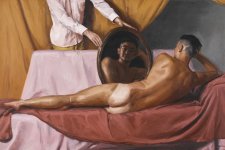
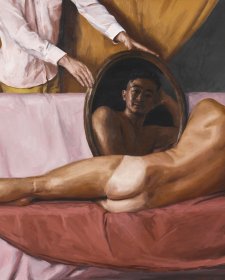
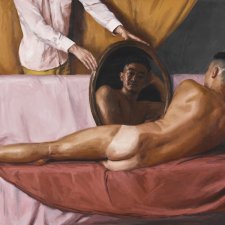
Preserving stories, subverting power and posing nude: Benjamin Law explores the potency and persuasiveness of portraiture.
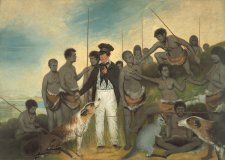
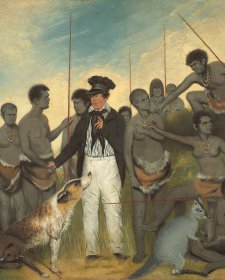
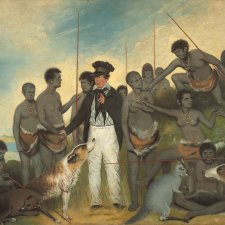
Gareth Knapman explores the politics and opportunism behind the portraits of Tasmania’s Black War.